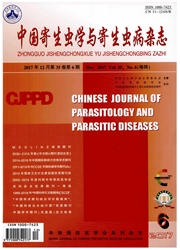

 中文摘要:
中文摘要:
2006年分别选择青海省玉树、治多和称多等3县(州)的2个镇6个乡共27个自然村,对1岁以上常住居民用间接红细胞凝集试验(IHA)和B超进行棘球蚴病诊断检查。IHA共检2251人,抗棘球蚴抗体IgG阳性率为9.2%(207/2251);B超共检2581人,患病率为4.1%(106/2581)。女性IHA阳性率和患病水平(分别为11.3%和5.0%)均高于男性(分别为6.6%和3.0%)。IHA血清阳性者中,40岁组最高,占16.4%;患病率则随年龄增长而升高,60岁以上组最高,占15.5%。不同职业人群中IHA血清阳性率和患病率均以半农半牧为最高,分别占21.5%和11.4%。玉树州人群棘球蚴病抗体阳性率和患病率均处于较高水平。
 英文摘要:
英文摘要:
Local inhabitants in 8 towns/townships of the counties Yushu, Zhiduo and Chengduo were examined with serology and ultrasound in 2006. Among 2 251 people tested by indirect hemagglutination (IHA), 207 showed antihydatid IgG positive (9.2%). Ultrasound examination found 106 cases out of 2 581 people, with a morbidity of 4.1%. Females showed higher sero-positive rate (11.3%) and morbidity rate (5.0%) than males (6.6% and 3.0% respectively). The highest sero-positive rate was in the group of 40-49 years old (16.4%). The morbidity rate increased with age, with the highest rate (15.5%) in the group of 60 years old and above. Occupationally, those involved in semi-agriculture and semi-animal husbandry showed highest sero-positive rate and morbidity rate, 21.5% and 11.4% respectively. The survey demonstrated that the prevalence of hydatid disease in human population is at a high level in Yushu Tibetan Autonomous Prefecture.
 同期刊论文项目
同期刊论文项目
 同项目期刊论文
同项目期刊论文
 期刊信息
期刊信息
